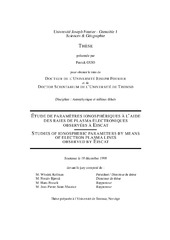Studies of ionospheric parameters by means of electron plasma lines observed by EISCAT
Permanent link
https://hdl.handle.net/10037/2976View/
Entire thesis in one comprehensive file (PDF)
P. Guio, N. Bjørnas and W. Kofman: 'Alternating-code experiment for plasma-line studies', Ann. Geophysicae 14, 1473-1479 (1996) (PDF)
P. Guio, J. Lilensten, W. Kofman and N. Bjørnå: 'Electron velocity distribution function in a plasma with temperature gradient and in the presence of suprathermal electrons: application to incoherent-scatter plasma lines', Ann. Geophysicae 16, 1226-1240 (1998) (PDF)
P. Guio: 'A simple model for the velocity distribution of particles in a plasma with temperature gradient', Ann. Geophysicae manuscript (1998) (PDF)
P. Guio and J. Lilensten: 'Effect of suprathermal electrons on the intensity and Doppler frequency of electron plasma lines', Ann. Geophysicae 17, 903-912 (1999) (PDF)
Thesis introduction (PDF)
Date
1998-12-18Type
Doctoral thesisDoktorgradsavhandling
Author
Guio, PatrickAbstract
This work presents a study of the electron plasma lines observed by the incoherent scatter radar EISCAT. The work is focusing on two parts. On one hand, the design of a plasma line experiment for the EISCAT system with an improved spatial resolution. On the other hand, the comparison of the plasma line data collected with the EISCAT radar with an improved model for the intensity and the Doppler frequency shift of the plasma lines. In order to improve the spatial resolution of the plasma line experiment we have designed the first experiment that implements the recent technique of alternating code. The experiment has been run successfully with an altitude resolution of 3kmas opposed to 40– 50km obtained with the
conventional techniques. Because it is very difficult to construct a self-consistent model of the velocity distribution function encompassing all of the relevant energy range, we have made an ad hoc model by separating the distribution into two parts: the thermal and the supra-thermal population. The thermal population is represented by the Spitzer function that takes into account the effect of an electric field and/or a temperature gradient. The supra-thermal population is derived from the angular energy flux of the supra-thermal electrons calculated by a numerical electron transport model. A numerical code has been developed to calculate the dielectric function and the reduced one-dimensional velocity distribution for any
arbitrary two-dimensional velocity distribution which are needed to model the intensity and the Doppler frequency shift of the plasma lines. We have been able to reproduce peculiar features of the intensity as well as the Doppler shift of the
plasma lines with data collected with the EISCAT VHF radar. Especially, two sharp peaks in the supra-thermal distribution were identified as the signature of photo-ionisation of N2and Oand were observed in the measured data. The effect of the temperature gradient—which produces a decisive correction to the Doppler shift of the plasma lines—was taken into accountmore accurately than previously by numerical evaluation of the singular integrals rather than by the use of the first terms of a series expansion as done in other studies. This is important because it has allowed a model for the first time to reproduce accurately the intensity and the Doppler shift of the plasma line as measured by actual experiment. Ce travail présente une étude des raies de plasma observées à l’aide du radar à diffusion incohérente EISCAT. Le travail est centré sur deux points. Tout d’abord, la conception d’une expérience raies de plasma pour le radar EISCAT, avec une résolution spatiale améliorée. Puis, la comparaison de données raies de plasma acquises avec le radar EISCAT avec une théorie améliorée sur l’intensité et le décalage Doppler en fréquence des raies de plasma. Pour améliorer la résolution spatiale, nous avons conçu la première expérience raies de plasma mettant en oeuvre
la technique du code alternatif. Cette expérience a été tournée avec succès avec une résolution spatiale de 3kmau lieu de 40– 50km obtenu avec les techniques conventionnelles. Parce qu’il est très difficile de construire un modèle cohérent
de la fonction de distribution des vitesses des électrons satisfaisant tous les intervalles d’énergies pertinents, nous avons construit une représentation adéquate de la distribution des vitesses des électrons en séparant la distribution en deux populations : la thermique et la suprathermique. La population thermique est représentée par la fonction de Spitzer qui tient compte de l’effet d’un champ électrique et/ou d’un gradient de température. La population suprathermique est déduite du flux angulaire d’énergie calculé grâce à un modèle numérique du transport des électrons. Un code numérique a été développé pour calculer la fonction diélectrique
et la fonction réduite de distribution des vitesses pour toutes distributions des vitesses à deux dimensions dont nous avons besoin pour modéliser l’intensité et le décalage Doppler en fréquence des raies de plasma. Nous avons pu reproduire les caractéristiques de l’intensité et du décalage Doppler en fréquence des raies de plasma avec des données mesurées avec le radar VHF EISCAT. En particulier, nous avons identifié deux pics étroits dans la distribution des vitesses des suprathermiques comme la signature de la photo-ionisation de N2et O. Ces pics
ont été observés sur les données. L’effet d’un gradient de température—qui produit une correction importante au décalage Doppler des raies de plasma—a été pris en compte plus précisement que précédemment en calculant numériquement les intégrales singulières, au lieu d’utiliser les premiers termes d’une expansion
en séries comme auparavant. C’est important car cela a permis pour la première fois à un modèle de reproduire précisément l’intensité et le décalage Doppler des raies de plasma mesurés par une expérience EISCAT.
Publisher
Universitetet i TromsøUniversity of Tromsø
Metadata
Show full item recordCollections
Copyright 1998 The Author(s)
The following license file are associated with this item:


 English
English norsk
norsk
